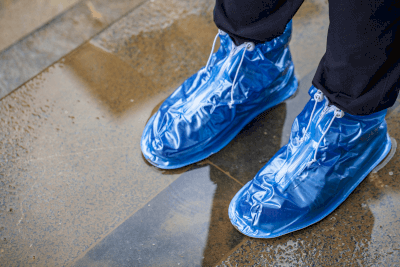What Is a Rubber Overshoe?

Rubber overshoes are worn over regular shoes to protect and keep them clean. They are sometimes referred to as shoe covers and are available in various shapes and sizes, including disposable, slipper, and boot types.
Rubber overshoes can be broadly categorized into two types: waterproof and cold-proof shoes for outdoor use, and dirt-preventing shoes for clean rooms and other specialized applications. General-purpose rubber overshoes for rainy days are also available.
Recently, there has been increasing demand for their use in medical facilities to prevent infections.
Uses of Rubber Overshoes
Rubber overshoes are commonly used for trekking and other outdoor activities. They can be worn over shoes to provide protection from the cold and keep feet dry. Rubber overshoes are seam-free, ensuring their waterproof effectiveness as long as they remain hole-free.
Rubber overshoes are also suitable for use in clean rooms, medical workplaces, and other environments where preventing the introduction of dust and dirt is crucial. Disposable types are used in areas with concerns about asbestos or environmental contamination.
Principle of Rubber Overshoes
Non-disposable trekking types often have a boot shape and utilize highly abrasion-resistant materials for the soles, some of which can be attached to snowshoes. Slipper types are typically large enough to fit over regular shoes.
Disposable types are made from non-woven fabric, PVC, or plastic. Some models cover the thighs, but most only cover the ankles. To enhance grip, some of them feature a non-slip coating on the bottom.
Non-woven fabrics offer good air permeability and may include an anti-static function, although they can be slightly slippery. The mouth of the footwear is made of rubber and provides a moderate level of tightness.
Plastic products are generally well-sealed, have poor slip resistance, and often feature a rubber opening at the top. Some products incorporate PVC coatings for waterproofing. They are used in decontamination work, factory tours, briefing sessions, and entering/leaving food processing plants, allowing users to keep their shoes on.
How to Choose the Right Rubber Overshoes for Safety Shoes
Safety shoes are worn by workers in factories and construction sites. According to certain standards, they are defined as “shoes primarily designed to protect the wearer’s toes with reinforced leading edges and equipped with an anti-slip system.” In environments with heavy objects and dangerous equipment, such as factories and construction sites, there is always a risk of industrial accidents. Safety shoes incorporate hard materials like steel plates in the toe area and non-slip soles to prevent foot injuries from falling objects or work-related errors. Many safety shoes also feature materials that dissipate static electricity.
In some factory settings, rubber overshoes are worn over safety shoes for hygiene and waterproofing purposes. When selecting rubber overshoes for such use, it’s crucial to consider the aspect of “static electricity.”
For example, when handling fine powders like printer toner in environments where static electricity discharge can ignite flammable materials, the risk of a dust explosion exists. This risk extends to situations involving liquids and gases as well. Therefore, when choosing rubber overshoes, be cautious not to select materials (like cloth) that may generate static electricity.
Slipper-Type Rubber Overshoes That Can Be Worn With Shoes
Slipper-type rubber overshoes are now available for individuals who don’t typically work on factory sites or engage in inspections. Many of these products are made from vinyl material and feature insoles and soles designed to prevent slipping when worn over shoes. Unlike traditional slippers, they are larger in length, width, and height, allowing them to be worn over regular shoes with ease.
In certain transportation and logistics operations where changing footwear significantly reduces efficiency, these slipper-type rubber overshoes enable wearers to keep their outside shoes on while using the slipper overshoes.